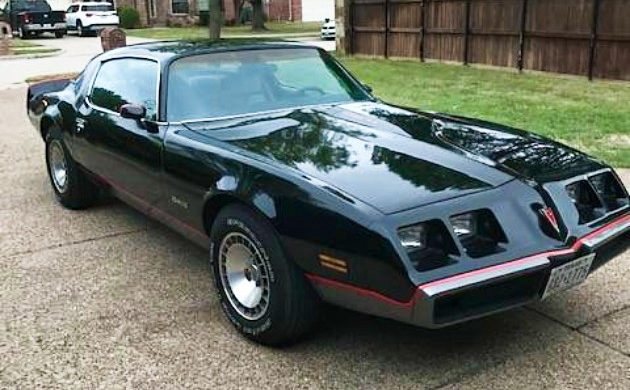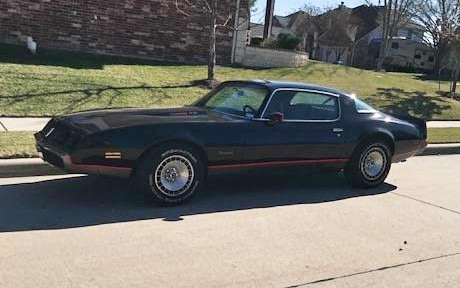Total sales for Pontiac’s Trans Am/Formulas hit an all-time high in 1979. The next year, Pontiac introduced the Turbo Trans Am/Formula as the top performer. On paper, the cars look comparable but on the street, owner’s soon realized the turbo engine was not a match for Pontiac’s large displacement engines. Sales plummeted by more than 50% for the Trans Am/Formula in 1980 and only a few 1980 Pontiac Turbo Formulas were built. This example looks to be in good condition and has been sitting for a number of years. It is listed for sale here on craigslist for $18,950. The car is located in the Dallas/Fort Worth area in north-central Texas.
The engine compartment is crowded on this car but clean. Cubic inch displacement for the top-performing engine dropped from 400 cubic inches and 220 horsepower in 1979 to 301 cubic inches and 210 horsepower in 1980. That did not seem like too big of a drop in horsepower even though cubic inches declined by 25%. However, 0-60 times for the two cars were vastly different. The W72 powered 1979 Trans Am/Formula ran 0-60 in 6.6 seconds and the quarter-mile in 14.6 seconds. The 1980 Turbo Trans Am/Formula ran 0-60 in 8.1 seconds and the quarter-mile in 16.3 seconds.
The interior of the Pontiac Trans Am/Formula has always looked impressive. The seller claims that the dual-gate shifter is a factory option. The car is loaded with options including cruise control, tilt steering, air conditioning, AM/FM Radio, and the optional Formula wheel which was standard on the Trans Am. The odometer is reported to show approximately 66,000 miles and the Formula has been stored most of its life.
The car was repainted in its Starlight Black about 14 or 15 years ago. The seller reports a leaking power steering assembly which probably means the steering box needs to be rebuilt. I just replaced this unit on my 1979 Formula and the units cost about $500 to $700 for a rebuilt WS6 unit. The car is said to be rust-free and to run well. This car has the factory WS6 suspension option which made it one of the best-handling cars of its time according to Car & Driver.






Needs an LS and a nose job
That’s what your wife said….
That’s what your wife said….
My question has always been in regards to the slight depression far right dash under the 2 vents all these have, looks like a blank out but it’s stamped and I have never seen it filled with anything, so why, what am I missing on this?
Optional rear defroster switch.
Also the power door lock switch, that’s where it was located on my 1970 Firebird.
Steve R
Rear defrost and Audio fade/balance switches go here if equipped
Optional Audio balance and fade plus rear defrost switches go here if equipped
Kolin, the audio switch actually controlled audio “boost” with high or low option. https://www.ebay.com/itm/254233822024?hash=item3b31844348:g:VloAAOSwuXlb0P1S
Yes I was incorrect. Thank you
The 301 Turbo was a complete dog but I don’t think that’s why sales plummeted. The economy was in the toilet, we just suffered the second oil embargo, there was an Iranian hostage crisis, inflation was out of control, and interest rates were high. Probably 15% on a new car loan with good credit. Industry-wide, auto sales were down about 20%.
The TA/Formula declined by a much higher percentage but Z28 sales also declined by about half, and it had the same 350 as ’79 but with 15 more horses due to air induction.
I think this was because these cars were getting long in the tooth, and aound this time, rumours began that a new generation was coming. Which it ultimately did for 1982 of course.
You know I always wandered growing up in the 80’s why the back end looked so low? I didn’t realize till now that GM had put a sewing machine motor in. I always thought it was the shackles/springs but actually maybe the motor wasn’t heavy enough to bring the front end down to make it look even.
That’s not why. Second generation firebirds were purposely designed lower in the rear to give it the appearance of speed. 301 Firebirds had different springs to make up for the lighter301. A 400 car would have had stiffer springs in front.
The optional roof drip rails & side window trim are chrome, clashing with the dumb factory painted over black front & rear big glass moldings.
What a difference under the hood, comparing all the empty space you see on even a ’76 455 with no a/c no airpump 49 state 1970 bird.
https://cdn-0.barnfinds.com/wp-content/uploads/2020/07/1976-Pontiac-Trans-Am-4-630×390.jpg
This ’80 even has an airpump – not tinker friendly.
Steve R. The door lock switch that used to reside on the dash for 1970 to 76 models migrated to the doors. Was a good ides to get rid of it, as it had an “Autolock” function, and would lock when you closed the doors and suddenly realized you left your keys in the ignition, locking you out. I knew a guy with a brand new 1976 Trans Am, who after getting locked out 3 times, started carrying a spare door key in his wallet.
I had a 1980 Turbo T/A from 1985 to 1995. When the original smog air pump decided to fail, I wanted to just take it off and put a smaller belt on, but the pulley arrangement would not line up, so I gutted the impellers, and made it into an idler pulley so the original v belt would still work. Kind of a Farm Boy fix, but it worked.
Then the turbo center seal failed at 55,000 miles, and I scraped a lot of skin off my knuckles changing that unit out.
In Australia the dash mounted door lock/unlock switch was short lived because it made it easier to break into the car. You only had to force the top section of of the door open a fraction to slide a steel rod in past the door seal to push the door lock/unlock button. It was also a popular method used by Road Side Assist guys if you locked your keys in the car!
Pontiac did offer a dual gate shifter, not sure what years, but I have one I installed in my 78 Smokey and the Bandit vehicle. The turbo engine was a joke, no way it only had 10hp less, it was a dog compared to the 400
Also know as the turdbo T/A…